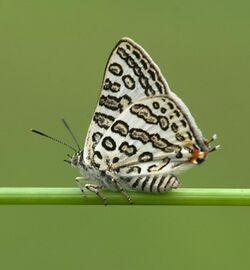Biology:Aphnaeus lilacinus
From HandWiki
| Lilac Silverline | |
|---|---|

| |
| Scientific classification | |
| Kingdom: | Animalia
|
| Phylum: | |
| Class: | |
| Order: | |
| Family: | |
| Genus: | |
| Species: | A. lilacinus
|
| Binomial name | |
| Aphnaeus lilacinus Moore, 1884
| |
| Synonyms | |
| |
Aphnaeus lilacinus, the lilac silverline,[1] is a species of lycaenid or blue butterfly found in Asia.[1][2][3]
Range
The lilac silverline is found in India , Myanmar and N.Thailand.[2] In India, this butterfly is found in the Bangalore[4] and the Daying Ering Wildlife Sanctuary (DEWS) in Arunachal pradesh.[5]
Description
Male. Upperside brown. Forewing with the basal and discal areas blue, somewhat iridescent blue in certain lights. Hindwing with the basal and inner space similarly blue, an orange-ochreous anal patch, a small black spot in the anal lobe, sometimes another on the margin in the next interspace; tails black, tipped with white, the orange-ochreous colour running half way up them; both wings with the outer marginal line blackish-brown. Cilia white. Underside pale brownish-ochreous, bands slightly darker than the ground colour, finely edged with black, with silvery scales down their middle. Forewing with a small sub-basal round ringed spot in the cell, an oval lajger spot in the middle and another at the end, the last joined on its lower side to a curiously shaped larger spot, of a jagged spear-sliape with a small nodule attached to its lower end, then four round ringed spots near the costa in an irregular triangular form, the outer two the larger, a sub-marginal chain-like macular band from near the costa, broadening gradually hindwards to vein 2, with a black suffused continuation to near the hinder margin, a line of black lunules close to the margin which has a blackish line. Hindwing with three sub-basal ringed spots in a line, well separated from each other, a medial nearly straight band of four conjoined longish and squarish spots, and a discal band of three similar spots, the sub-marginal band and marginal markings as in the forewing, but narrower and not so well pronounced. Female. Upperside dull brown, larger than the male, the wings broader, the outer margin more convex, otherwise both above and below it is similar.
Gallery
References
- ↑ 1.0 1.1 R.K., Varshney; Smetacek, Peter (2015). A Synoptic Catalogue of the Butterflies of India. New Delhi: Butterfly Research Centre, Bhimtal & Indinov Publishing, New Delhi. pp. 94. doi:10.13140/RG.2.1.3966.2164. ISBN 978-81-929826-4-9. https://www.researchgate.net/publication/287980260_A_Synoptic_Catalogue_of_the_Butterflies_of_India.
- ↑ 2.0 2.1 "Cigaritis lilacinus (Moore, 1884)". http://www.nic.funet.fi/pub/sci/bio/life/insecta/lepidoptera/ditrysia/papilionoidea/lycaenidae/theclinae/cigaritis/#lilacinus. Retrieved June 30, 2018.
- ↑
 One or more of the preceding sentences incorporates text from a work now in the public domain: Swinhoe, Charles (1911-1912). Lepidoptera Indica. Vol. IX. London: Lovell Reeve and Co.. pp. 170–171. https://www.biodiversitylibrary.org/item/103505#page/182/mode/1up.
One or more of the preceding sentences incorporates text from a work now in the public domain: Swinhoe, Charles (1911-1912). Lepidoptera Indica. Vol. IX. London: Lovell Reeve and Co.. pp. 170–171. https://www.biodiversitylibrary.org/item/103505#page/182/mode/1up.
- ↑ "Apharitis-lilacinus Moore, 1884 – lilac silverline". http://www.ifoundbutterflies.org/#!/sp/2125/Apharitis-lilacinus.
- ↑ "The Arunachal Times". 27 May 2018. https://arunachaltimes.in/index.php/2018/05/28/rare-butterfly-species-spotted-in-dews/. Retrieved 29 May 2018.
Wikidata ☰ Q4779628 entry






